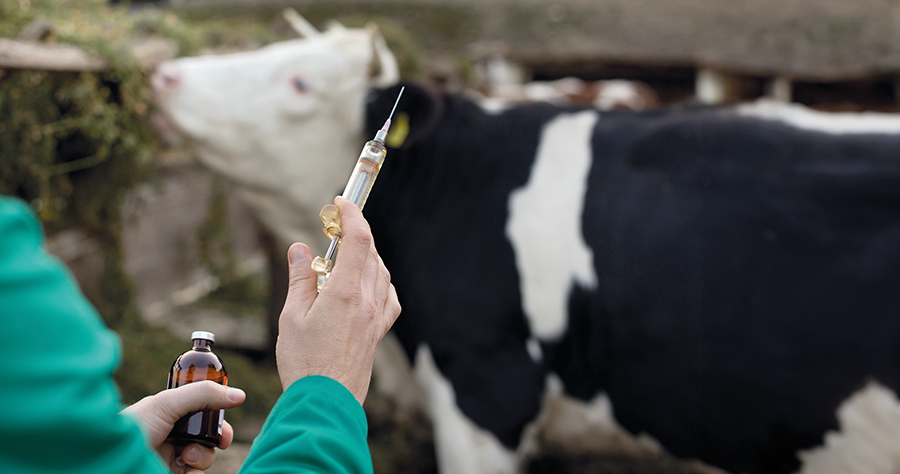Vaccination: Make sure you don’t waste your investment
18th October 2024
SRUC veterinary investigation officer, Fiona Crowden, offers advice on steps you can take to make sure your vaccinations are effective.

Often, vaccines administered to cattle and sheep represent a significant financial investment, so it’s important they are used correctly – the best way to make a vaccine even more expensive is by using it in a way that means it doesn’t work.
The most important point to remember is that vaccines are an aid to control a disease, rather than an absolute preventative. Taking a parallel with the Covid-19 vaccinations, while vaccines decreased the severity of disease and reduced deaths, they did not provide absolute protection against infection, illness or deaths – and the same is true of veterinary vaccines.
It is always important to consider the factors which contribute to the disease you are trying to control. Vaccination is often used to prevent respiratory disease in cattle, however if shed ventilation is poor, with draughty areas, damp bedding, and/or regular mixing of stock, then respiratory disease is still likely to be a significant issue. Effectively controlling disease requires the risk factors to be considered, controlled, and minimised as far as is possible within that system, alongside the use of vaccines.
Storage
Ensuring vaccines are stored properly is an essential part of maintaining their effectiveness. Most vaccines should be stored between 2-8ºC, however studies have found that perhaps half of medicine fridges could be too warm or too cold. Using a digital thermometer probe placed in the fridge with an external screen, or a temperature logger, are cheap and simple ways to monitor temperatures.
Also ensure that vaccines are kept cool prior to use – a live EAE vaccine left in the farm truck while the ewes are gathered can be inactivated.
Attention should also be paid to the time a vaccine remains effective after opening the bottle – usually between 2–8 hours, with leftover broached vaccine discarded after this time. The data sheet found within the packaging of all vaccines will provide details of the specific conditions of storage/use.
Timing
The timing of vaccinations is also important to ensure they are effective. Very broadly, vaccines work by ‘training’ the immune system to look for a particular part of a bacteria or virus, to produce specific antibodies to identify and neutralise the specific disease if infected in the future. Generating immunity is a biological process and takes time, therefore courses of vaccines and boosters are given at the intervals featured on the data sheet, generally in advance of the risk period.
There is sometimes a practical trade off on farms when animals are outdoors, where periods of adverse weather mean that animals should not be handled or vaccinated, not least because of the risk of causing abscesses and spreading infection when animals are wet/dirty.
Vaccines given to pregnant cows and ewes to help protect their offspring from disease (e.g. clostridial vaccines in ewes, calf scour vaccines) work by stimulating the dam to produce antibodies in the colostrum. The timing of vaccination is important, but it is critical for newborn lambs and calves to get sufficient colostrum from the dam in the first hours of life in order for the desired immunity to be transferred.
Administration
Route of administration is another key area where things can go wrong – at best the vaccine may not work, and at worst it can cause the death of the animals. The most common routes for vaccination in ruminants are subcutaneous (under the skin), intramuscular (into the muscle) and intra-nasal (up the nose). Again, the data sheet will instruct the route and usually the area of administration.
A vaccine intended to be given under the skin, behind the ear in sheep can cause large tissue reactions when given into the muscle and can occasionally be injected close to or into the spinal column, with fatal consequences. Selecting the correct length of needle helps to avoid misplacement of vaccines.
Cross-reactions and interactions of vaccines and other medicines is another area to be aware of. Treating lame sheep with oxytetracycline antibiotics at the same time as using a live enzootic abortion vaccine will lead to the antibiotic killing the vaccine.
Similarly, using wormers at the same time as the live lungworm vaccine has a similar effect. Sensitisation of sheep to the excipient polysorbate 80 (present in Footvax, Cydectin 1% injection and Porcylis Ery), means that treating sheep with two of these products in their lifetime can cause fatal adverse reactions.
Vaccines are key to controlling disease on farms, however there are many situations where the vaccine you have invested in may be prevented from being effective. Even with vaccines you have been using for years, taking time to read the product data sheet, and ensuring you are using the vaccine correctly, will be time well spent.
Read more livestock news
